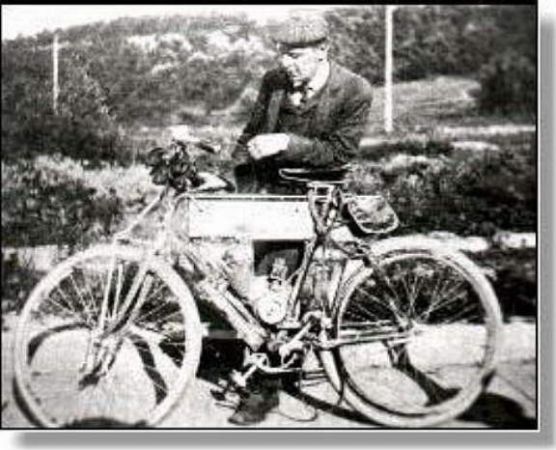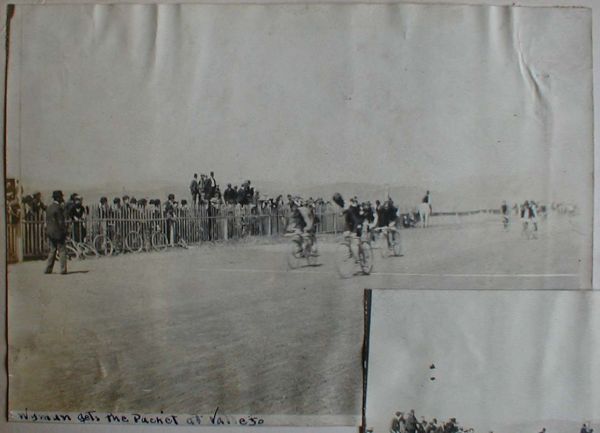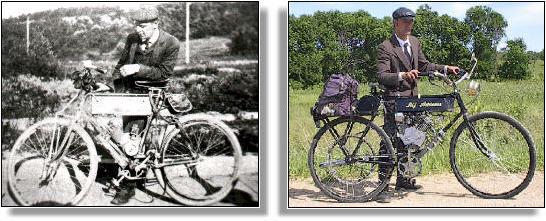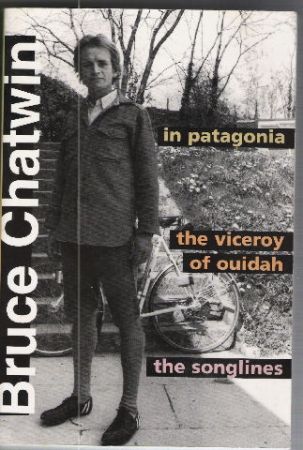U
uncle_punk13
Guest

In 1903 a young gentleman from San Francisco by the Name of George A. Wyman rode, pushed, pulled, carried, and crawled his 1902 "California" brand motor bicycle from San Francisco to New York City. He achieved this monumental undertaking before the first automobile crossing by Dr. Horatio Nelson Jackson (in his Winton Automobile) and made better time, finishing his adventure in New York City at the "New York Motorcycle Club" rooms, 1904 Broadway, a mere 50 days after departing San Francisco. Amazingly, over half of Mr. Wyman's journey was accomplished by pounding over the ties of the trans-continental railroad as there were no "real" roads in the sense that we, in the modern age, have come to think of roads- asphalt, concrete, or tar and gravel, to travel upon.
Patented and manufactured by Roy C. Marks, the 'California' motor bicycle was produced from 1901 through 1904; in 1904 this company was sold to "Consolidated Manufacturing" of Toledo, Ohio and became the "Yale" motorcycle. 1904 and 1905 were the only years for the "Yale California" ('Yale' make- 'California' model). Coincidentally 1903, the year of Mr. Wyman's coast-to-coast journey, was a landmark year filled with "first" accomplishments. The first "Harley-Davison" motorcycle was produced, the first year of Henry Ford's famous automobile company, as previously mentioned, this was the year of the first automobile crossing of the U.S., the year the first Tour De France bicycle race was run, and the first flight of the Wright Brothers airplane; just to name a few.
George A. Wyman's account was originally published in a series of articles and in his own words in "The Motorcycle"; a periodical of the time dedicated to motorcycling. "The Motorcycle" was a relatively short-lived periodical, in publication from 1903 until 1906, and yet played a key role in the history of motorcycling. George A. Wyman's incredible account was in their premier issue (Issue 1, Volume1, June 1903).
Unfortunately, this accomplishment was for the most part lost and forgotten. George A. Wyman never received the credit he was due for this historic feat. This series of articles was found and reprinted in a special edition of "Road Rider" magazine (courtesy of the late Roger Hull) in it's complete form in the late 1970's (1979). Yet again it was lost and forgotten; until published, ininstallments, in the early 1990's in 'The Antique Motorcycle' a publication of the Antique MotorcycleClub of America. Still Mr. Wyman and his accomplishment remained somewhat obscure. In 2002 a friend of mine discovered it and I received in the mail a manila envelope containing a Xerox copy of the Story.
At once I began to read this astonishing account of trial, failure, and triumph. Once finished, I immediately started over again; scarcely believing what I held in my hands! I became enthralled with George Wyman and his incredible feat. I was moved by the great grace and tickled by the humor with which he endured the hardship of this adventure. For years now I have been doing research to find out more about Mr. George A. Wyman, and in July 2003 arrived back home from having finished re-creating his incredible journey to celebrate the 100th anniversary of his achievement.
Born in 1877, in California, George A. Wyman at age 25, who was a member of the Bay City Wheelmen and a bicycle racer, became the first person to cross the Sierra Nevada Mountains with a motor vehicle in 1902; riding his 1 1/2 horsepower California brand motor bicycle to Reno, Nevada for a bicycle-racing event at the Reno Fairgrounds. George arrived on August 31st, 1902 awaiting the arrival of his comrades who brought his racing cycle along by rail one week later for the big race, against rival cyclists the Reno Wheelmen, on Sept. 7, 1902.
[/b]

It was this trip to Reno that gave Mr. Wyman the inspiration to attempt the first crossing of the American continent on his motor bicycle.
To quote George (from his original 1903 text) while he was traveling over the Sierra mountains:
"I was traveling familiar ground. During the previous summer I had made the journey on a California motor bicycle to Reno, Nevada, and knew that crossing the Sierras, even when helped by a motor, was not exactly a path of roses. But it was that tour, nevertheless, that fired me with the desire to attempt this longer journey - to become the first motorcyclist to ride from ocean to ocean."
George A. Wyman left the corner of Market and Kearney streets in San Francisco, CA at 2:30 P.M on May 16, 1903 and arrived in New York City on July 6, 1903; enduring many hardships and heartbreaks while en route, yet he still manages to tell his story with a great grace, humility, and wit that could only be described as true American spirit.
George did in fact become the first motorcyclist to cross this great land of ours, he then disappeared into obscurity receiving no credit in the pages of our history books for his accomplishment. He also seemed to have just disappeared; we have been doing genealogical research (along with all of the other research concerning the vehicle, the geography of the time, the route traveled, etc.) and have only recently had a breakthrough with the rest of his story. Fortunately, I have been able to discover a little bit about what happened to George A. Wyman after his continental crossing. Here is what we have discovered:
It would appear that George continued to follow his interest in motor vehicles as he worked in different capacities relating to motor vehicles.
According to the 1910 census George had returned to San Francisco where he was working as a mechanic and chauffer, while residing at the Dorel Hotel, 1507 California Street. The 1920 census tells us that George, at age 43, was at this time married with three children, and was working as a second hand automobile dealer / salesman. His wife Nellie Wyman, (maiden name Lovern) age 41, had brought a child into the union; her son Harold, age 19, was a clerk for the Railroad. George and Nellie had also conceived two children of their own- son William (Billy), age 4; and son Richard, age 2. George A. Wyman had relocated from San Francisco by this time. He and his family apparently were now residing in Eureka, California. In the 1930 Census, George is still living in Eureka, CA with his two sons William and Richard. George is now working as an automobile mechanic. There is no record of his wife Nellie residing with him at this point.
Through a search of the Social Security Death Index we discovered that George A. Wyman, the first motorcyclist to cross the Continental United States, left this world November 15, 1959 at age 82 in San Joaquin county, CA. Furthermore, we found that his youngest son, Richard Charles Wyman, passed away on the 29th of August, 1988 in Humbolt county, city of Eureka, CA.
We have not found a death for George's son William; yet we have not located him as still living either, although we are continuing to do our research.
In October of 2003 Bob Johnson, who built an exact replica of the California motor bicycle, had it on public display, and was heavily involved in the centennial re-enactment, was contacted by a Mr. Jon Wyman, a direct living descendant of George A. Wyman. In 2004 I myself was contacted by a Ms. Marti Wyman Schein - George Wyman's Great granddaughter, who is also a motorbike / motorcycle enthusiast.
My research continues as I find time'
Across America on a Motor Bicycle
-2003-
Rif Addams
Who really knows how things like this get started. I suppose, in retrospect, that it must have actually had it's roots in my childhood. That first shiny red and white tricycle probably. I can remember pedaling faster and faster until my tiny Keds, the pedals, and the front wheel were nothing but a furious blur all the while making 'brrrrrr-ing' motor noises with my tongue and lips, spraying a fine mist of spittle everywhere.
Going faster and faster I pedaled like a maniac to the very edge of the boundary area that I was not allowed to ride past. There I would sit; gazing off into the distance, down the driveway, and further on down the road into the horizon. I was young with my blood boiling, mental gears grinding, all the while still making my motor noise, and rocking the front wheel over the imaginary line and back; just back and forth, pushing the limit. I would sit there for what seemed to me hours. In reality it was probably 1.5 minutes before I was back at it, tearing around like a maniac; leaving a cloud of dust in my wake, spinning round and round the circular area of the drive, back wheels sliding, as the tricycle precariously tipped up onto two wheels, then SLAM! With all wheels back on the ground, I would commence to furiously peadal again and tear off, back to the edge of my cage.
I would sit there dreaming the timeless, ageless dreams of freedom; those visions of exploration began expanding that small world of mine, these are the hauntings that filled my head and spirit. I was probably three or four years old at that time and completely unaware, I'm sure, of what was happening; that stirring in my soul. Hell, I probably didn't even comprehend that I had a soul or any other such idealism at that point. All I knew is that I wanted to ride man, just go; to pedal farther, faster, and to feel the wind in my face blowing my blond hair all around. That all became even more pronounced with the first real "big kids" two-wheeler I received for my birthday from my grandparents now many long years ago and was probably the catalyst, although dormant for twenty years, tht eventually made me ride that faux antique motor bicycle across America.
8)
First things first, but not necessarily in that order...
I would guess that of the many questions at the forefront of most people's mind, the first must be: "What would make anyone want to ride a motor bicycle across the country?
Honestly I really can't give any sort of real answer to that. It's just something that gets under the skin. The idea worms its way in, then sits there for awhile before it begins to burn and itch. Before long things begin to bend, twisting the fates until the next thing a person like me knows they're out there in the thick of it all, having the adventure of a lifetime on a Whizzer Motorbike in the middle of the United States. Taking the risk, blowing everything off for that one long shot; for that one opportunity, the one last chance. Making a break for it in order to take a delicious sip from the cup of 'True Freedom'.
The particular worm that crawled beneath my skin was that of George A. Wyman- Mr. Wyman's story is filled with hardships and breakdowns at every turn it seems, but he tells of these travels with great grace; in a very humorous and self depreciating manner that can only be described as true American spirit. I found it to be quite tragic and unfortunate that his story had been, for the most part, lost in the cracks of time.
Perhaps it was the way the story was told, as much as the adventure itself that captured my fancy. Quite possibly it was the sense of historical importance. I'm not certain what it was in particular about George and his great feat that grabbed me, but in any case the bug was in my skin.
I became enthralled with George Wyman and his incredible feat. I was moved by the great grace and humor with which he endured the hardship of this adventure. A group of us 'enthusiasts' banded together and decided that, this being the centennial anniversary of George's historic accomplishment, we should do something to celebrate that journey. It was decided that a recreation of the ride was perhaps in order. Having had that ageless spirit of adventure flowing through my blood stream ever since I was a young boy, well this story certainly did nothing to quench my thirst. This tale of action, adversity, and adventure from way back when- from a time when the world was still young and wild, with endless possibilities; well, the story was was more like using gasoline to extinguish a candle flame. I was in; and come hell or high water, I was going to do this thing and the consequences be damned!
We started by figuring out what to do about the vehicle itself. A 1905 'Mead Roadster' frame with front fork was acquired and modified in Texas, while in Washington (state) a two-cycle Westinghouse chainsaw engine was being modified and 'dummied-up' to semi replicate the original 'California' motorbike. We couldn't get a real one due to the facts that: (a) there are only three left in existence as far as our research turned up, and (b) Even if we could find one, who of us could afford the time and money to purchase and then restore it. Finally (c) barring those other two, who would be crazy enough to take an expensive, ultra-rare, antique motorbike on this sort of ride?!?! (I guess I might be...)
In New York the lighting assemblies were being fabricated from old brass alarm clock housings. From Iowa came the internal components for the New Departure Model D Rear coaster brake hub that was taken from my 1949 Schwinn DX. The spoke holes were then drilled out of this hub shell to accept .120" spokes. The 28" X 1 1/2" wheel rims and heavy duty spokes came from Texas as did 1905 period saddle and rear rack. In Washington (state) the hanging fuel tank and rear battery box were being fabricated. Everything was working well until just about a week before departure when it was discovered that the engine we had been modifying would not work in the vehicle. I made the executive decision to use a Whizzer power plant. This caused other issues, as the hanging fuel tank now would not fit.
The tank was modified, and upon it's being returned to me, I bolted it on. With everything assembled, adjusted, and such I took it out for a test ride. The gas tank began to leak. Perhaps leak does not quite give the complete visual story- have you seen pictures of niagra falls, or perhaps been there in person? I think it was closer to that than just a leak. The seam of the newly modified tank was coming apart. As near as I can figure, the heat of the engine was not only causing the fuel to heat up thereby casing the gasoline to expand, exerting outward pressure, but also softening the solder which was holding the tank at the seams.
I will spare you the boring details of the three days spent using different materials, methods, and techniques trying to get that bloody gas tank to hold fuel. Suffice it to say that none of this worked, so I bolted on the teardrop type tank that is supplied with the Whizzer engine kit and pronounced it, "good enough!". Unfortunately this caused much heartburn, contention, and dismay to some of my collegues; citing that it did not replicate closely enough the original bike. I wrote in my journal as a response to this, "Too bad kids, it's my ass in the saddle, out there on the road trying to make this trip, not yours. You want to run a problematic tank on your adventure, more power to ya'. I'm just trying to cut down on the amount of problems likely to be encountered while out there in the middle of nowhere..."
With only three days until departure from San Francisco, I still had not been able to get the inspection from the W.S.P. (Washington State Patrol) in order to license and register the vehicle as an 'antique motor-driven cycle'. With a stroke of luck we managed to get an appointment on the 11th of May. I had to get up at 4:00 in the morning- after having been up until 1:30 A.M. helping another team member wire the lighting and engine of the bike in order to transport the bike 2 1/2 hours away for a 7:00 a.m. (sharp!) appointment.
We did it! The bike now had a registration, plates, current tags, and was qualified to be ridden legally on the roadways. The rest of that time between the 11th and our projected take off date of the 14th was spent seeing to other minor details such as finishing minute crap on the bike, getting the bits together for the costume, packing, and getting supplies; one of which was making sure I had a coffee pot and coffee. That was, of course, the highest priority...

Last edited by a moderator:

